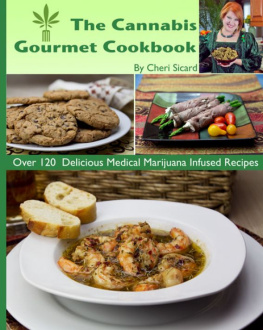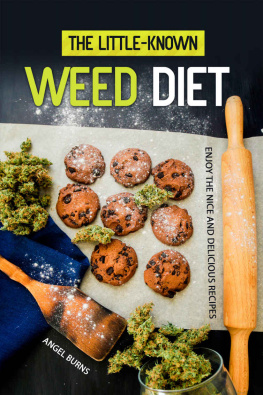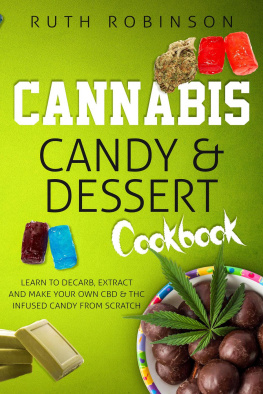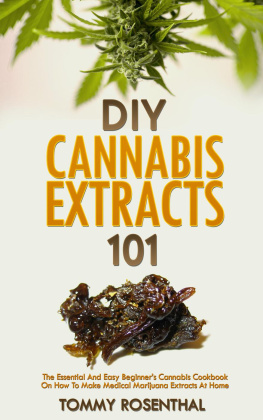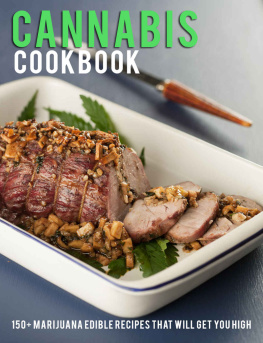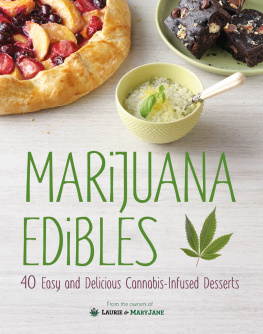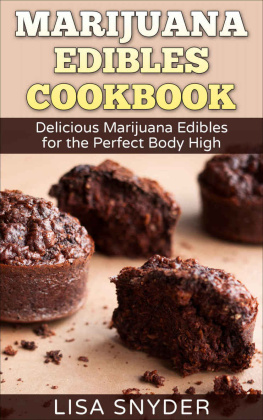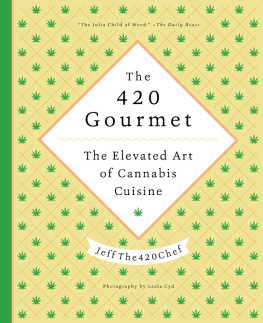
The Cannabis Gourmet Cookbook
Over 120 Delicious Medical Marijuana-Infused Recipes
By Cheri Sicard
Published by
Z-Dog Media, LLC
Smashwords Edition
Copyright 2012 by Cheri Sicard
Photography Copyright 2012 by Mitch Mandell
Library of Congress Control Number: 2011938109
Print Book ISBN: 978-0-9839888-0-9
EBook ISBN: 978-0-9839888-1-6
All rights reserved. No part ofthis publication may be reproduced in any form or by any means,electronic or mechanical, including photocopying and recording, orby any information storage and retrieval systems, without priorwritten permission from Cheri Sicard and Z-Dog Media,LLC .
This book is intended for informationalpurposes only and for adults only. Neither the author, thepublisher, nor anyone else associated with this book advocatesbreaking the law. Marijuana laws and penalties vary substantiallyfrom country to country, state to state, and sometimes even bycounty and city within states where medical marijuana is legal. Thereader is strongly advised to read, stay up-to-date, and follow thecannabis laws in their area.
For additional copies of TheCannabis Gourmet Cookbook along with marijuana news, politics, andmore great recipes, please visit my Web site, http://www.CannabisCheri.com .
Dedication
For Joe and Liz Grumbine, two of the kindest,bravest, and most inspiring people I have ever had the good fortuneto know. I am forever grateful for your friendship.
Acknowledgments
This book would not have been possiblewithout the help and support of so many people including, but notlimited to Sheila Smith Thomas, Mary Margaret Andrews, SteveNewman, Tanis Westbrook, and the wonderful folks at FavoriteRecipes Press; Mitch Mandell; Holly Clegg; Sam Sabzehzar; LannySwerdlow; Bambi Burnes; Chuck Burnes; Wanda Smith; Joe Grumbine;Liz Grumbine; Catrina Coleman; Jeff Spellerberg; Richard Burnes;Tracy Burnes; and all the amazing members of The HumanSolution.
Table of Contents

As a registered nurse workingin a clinic that provides patients with recommendations to usemarijuana, the large number of patients who are 55 and olderastounds me. When speaking with them about their reasons forwanting to obtain a m edical m a rijuana recommendation, I usually hear the same story: Oh,yeah -- I used to use marijuana whe n I was a teen and in my twen t ies, but I stoppe d a long time ago. I always follow upasking, Why did you stop?
The answers I get always follow a similarline:
Oh, I gotmarried, or, I hadkids, or, I stopped because of myjob, or, I justdidn t think Ishould anymore.
I havenever had on e p e r s o n t e l l m e th a t t h e y s to p p e d u s i n g m ar i j u a n a beca us e i t w as c a us i n g t h e m p r o b le m s , n o t on e !
Our great grandparents would likely concur.Prior to 1937, cannabis, in one form or another, was found in justabout every U.S. medicine cabinet.
Even our ancient ancestors would agree. Fivethousand years ago Chinese physicians wrote about their use ofcannabis, using it to treat pain, mental health problems, andfeminine problems such as menopause and menstrual cramps. Today weuse it for these same ailments and a veritable litany ofothers.
How can one plant providerelief from such a vast array o f differing ailments -- pain, depression, insomnia,lack of appetite, stress, glaucoma, menopause --t h e l ist g o es on and on and on? The answer liesin what might be called the active ingredients in marijuana-thecannabinoids.
Due to its psychoactive properties, THC isthe cannabinoid that gets all the hype, but it is only one of about60 cannabinoids found in marijuana. These complex organic moleculeshave a profound effect on our bodies, if for no other reason thanwe naturally produce cannabinoids, called endocannabinoids, for avirtual cornucopia of physiological processes. Ingesting marijuanais just supplementing the natural cannabinoids that our bodyproduces and, as such, cannabis should not be seen so much as amedicine but as a supplement.
T heterm phytocannabinoids refers to plants that produce compounds thatcan activate the bodys cannabinoid system. Although cannabis isnot the only plant to produce phytocannabinoids, it is the onlyplant that produces THC, and THC gets all the mediacoverage.
I dontmean to downplay the importance of THC -- it is vitally importantto our well being both in terms of everyday health andlongevit y . Itsjust that in order to truly understand the importance of ingestingcannabis for maintaining good health, we need to understand thecannabinoid system and the role all the cannabinoids play in thatsystem.
The endocannabinoid system is composed of anubiquitous number of cannabinoid receptors found in just aboutevery tissue and cell in our bodies, with the most abundantreceptors located in the brain. The system works as a biologicalregulator that maintains homeostasis, a physiological equilibriumresulting from a balance of functions and chemical reactions in ourbodies. The two main receptors are the CB1 receptors, located inthe brain and on neurons throughout the body; and the CB2receptors, which are mostly found in the immune system.
Cannabinoids call the shots in basicmetabolic processes and govern intercellular communication,especially in the immune and nervous systems. Cannabinoids that wenaturally produce (endocannabinoids) along with related compounds(phytocannbinoids) that are found in cannabis interact with ourcannabinoid receptors found in tissue, organ, and body systems,modulating and coordinating the functions of the cardiovascular,digestive, endocrine, excretory, immune, musculo-skeletal, nervous,reproductive, and respiratory systems.
The intimate association between our bodiesmultiple organ systems and the cannabinoid receptors that coverthem accounts for the unparalleled ability of cannabis to treatpain, depression, cancers, asthma, wasting syndrome, stress, headinjuries, insomnia, and a multitude of other ailments by providingsupplemental cannabinoids.
Dr. Robert Melamede, in h i s seminal publication Harm Reduction-- the Cannabis Paradox, published in the peer-reviewed H a rm Reduction Journal , proposes that,The homeostatic action of cannabinoids on so many physiologicalstructu r es andprocesses is the basis for the hypothesis that the endocannabinoidsystem is nothing less than a naturally evolved harm reductionsystem. Endocannabinoids protect by fine-tuning and regulatingdynamic biochemical steady states within the ranges required forhealthy biological function .
One of the major ways cannabis works topromote harm reduction is through its action as a potentanti-inflammatory. A powerful example is found in the ability ofcannabis to mitigate the effects of autoimmune diseases such asarthritis and multiple sclerosis. By inhibiting the consequences offree-radicals caused by these diseases, cannabis can significantlyslow the progression of these debilitating ailments.
Since one of the root causes ofthe aging process is also the production of excessfree-r a dicals, thecannabinoids found i n cannabis can actually slow the aging process itself. I am notsaying that cannabis is the fountain of youth -- it will not makeyou young again -- but due to its anti-inflammatory properties, theingestion of supplemental canna b inoids can slow not only the agingprocess, but also the development of age-related illnesses likecancer, cardiovascular disease, and Alzheimers disease.
One of the most amazing discoveries aboutcannabis that has only recently come to light is the anti-cancerproperties of this remarkable plant. Dr. Donald Taskhin, in a studyconducted for the National Institute of Drug Abuse, found thatmarijuana smokers are no more likely to develop lung cancer thanpeople who do not smoke marijuana. In fact he actually foundevidence that people who smoke marijuana are less likely to developlung cancer than people who do not smoke marijuana.
Next page
